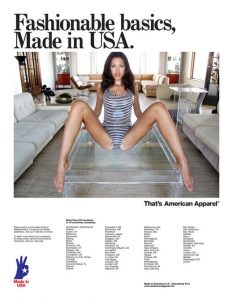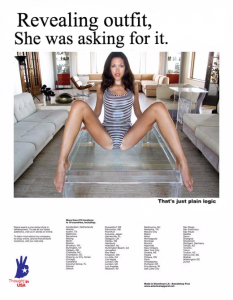The once-popular clothing brand, American Apparel, previously held mounds of potential during its infancy. Boasting a local-based production of their merchandise, the company seemed set to follow a socially-conscious path. However, with the emergence of a host of controversies surrounding the company’s advertising campaigns, American Apparel faced a rapid devaluation as a brand (Lam, 2017). In turn, the company’s devastating loss of profit and popularity provides an accurate manifestation of the power people’s perceptions of marketing campaigns have, in making or breaking the entirety of a business.
American Apparel advertisements are often easily recognizable-composed of the same white background and black text in Arial-type font, complete with a photograph of a scantily-clad female model. One such advertisement (as seen below) fits this template perfectly. Seemingly harmless, the ad looks to be endorsing a simple striped leotard. However, a great source of unease arises from the photograph of the model.

In the photograph, the woman is pictured wearing only a striped leotard. Her open positioning, with her legs spread wide and her arms stretched behind her, suggests the extension of a sexual invitation towards the viewer of the ad. This, in combination with her sultry facial expression, generates the sense that the model is beckoning the viewer to jump into the scene to join her. The sexual connotation is evident in the image, given the model’s outfit, and the way she is positioned and framed.
My discomfort with advertisement stems from the fact that it is playing a role in perpetuating a toxic idea-that a woman’s outfit is a sufficient indicator of sexual consent. By promoting an image that tightly entwines the idea of a barely-there outfit with a clearly sexually available woman, American Apparel is working to further cement the association between sex-clothing-consent. In addition to selling sex under the guise of selling clothing, this specific American Apparel ad is also propagating the idea that a woman’s clothes are enough to signal “yes” or “no” to the question of whether or not she would like to have sex.
__________________
In my own version of the American Apparel advertisement, I chose to alter the main text, “Fashionable basics, Made in USA” to something that more closely aligns with the true message being conveyed by the photograph. I decided to replace the main tagline to “Revealing outfit, She was asking for it” in order to make the original advertisement’s intention more explicit.
In addition to editing the main text, I also altered the text below the photograph from “That’s American Apparel” to “That’s just plain logic,” as well as the text included in the logo on the bottom left-hand corner of the ad, from “Made in USA” to “Thought in USA.” In making both changes, I was hoping to indicate the commonness and locality of the frightening and harmful thought, that a woman’s clothing is a satisfactory source of sexual consent on the part of the woman herself.

The edits this specific advertisement incurred under my hand were in no way, attempts to attack American Apparel itself. I simply wanted to highlight the ad’s part in sustaining the (sadly) common belief that a woman only has to wear certain types of clothing to signal her sexual availability, and a verbal “yes” or “no” from her is insignificant and means nearly nothing. As such, I wanted to invoke a sense of bewilderment in the viewers of my jammed ad, that such a horrendous message could be distributed by a widely-known brand.
As well, I intended to undermine the inconspicuousness of the message in the original advertisement. In making the allusion to rape clearer in my jammed ad, I was hoping to relay to its viewers, the need to be critical of all the media one encounters during daily life. All in all, the adjustments I employed to culture jam the ad were meant to raise awareness of the insidious use of advertising as a means of preserving social beliefs, and that (given the prevalence of patriarchal ideas) such beliefs are likely working against the best interest of women all over the world.
References
Lam, B. (2017, Jan. 14). Goodbye, American Apparel. Retrieved from
https://www.theatlantic.com/business/archive/2017/01/american-apparel-gildan/513128/
Original advertisement retrieved from
https://fdafmpol10.wikispaces.com/file/view/american_apparel.jpg/123322621/520×669/
american_apparel.jpg